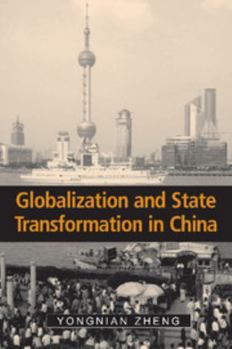Globalization and State Transformation in China
(Part of the Cambridge Asia-Pacific Studies Series)
Select Format
Select Condition 
Book Overview
Globalization has thrown up challenges and opportunities which all countries have to grapple with. In his 2004 book, Yongnian Zheng explores how China's leaders have embraced global capitalism and... This description may be from another edition of this product.
Format:Paperback
Language:English
ISBN:0521537509
ISBN13:9780521537506
Release Date:January 2004
Publisher:Cambridge University Press
Length:288 Pages
Weight:0.87 lbs.
Dimensions:0.6" x 6.1" x 9.0"
Related Subjects
Asia Business & Finance Business & Investing Business Development China Comparative Politics Development & Growth Economic Conditions Economic Policy Economic Policy & Development Economics Globalization Government History Legal Theory & Systems Non-US Legal Systems Political Economy Political Science Politics & Government Politics & Social Sciences Popular Economics Public PolicyCustomer Reviews
1 rating
China's flexible response to globalization
Published by Thriftbooks.com User , 16 years ago
We can hear "globalization" everywhere nowadays. Many believe that a global village will be formed in the coming future when the world is becoming more and more interdependent. And when different parts of the world share common values and norms, then we come to the age of globalization. However, Yongnian finds that China has a different path in responding globalization. To begin with, Yongnian figures out some of the impacts of globalization towards China such as increasing unemployment caused by economic reform; decentralization within China for the need to counter growing global economic competition; the rise of information technology which "has created new tool for political participation" (p.13) and hence leads to the emergence of civil society. Globalization simply weakens many states, China is no exception. Many argued that globalization has forced many states to comply the values, norms and rule of the game in the current international system, free market and free trade are the classical examples. Yongnian has come up with another perspective in chapter 2 and 3. No doubt that China needs to reform for globalization, but it does not mean that China has to conform all the things from the west. Since the late Qing dynasty, Chinese have already thought about "what and how to learn" from the west? (p.48) China's "socialist market economy" is indeed the result of "selective importation and innovation" from the west (pp.56-58). Thereafter, chapter 4 outlines the difference of political order in China before and after the economic reform. China's constitutional changes in 1975, 1978 and 1982, together with the constitution with amendment in 1999 as well as Jiang Zemin's three representation theory not only help to accommodate the changing socio-economic situation in China, but also justify the rationale behind the "Chinese" reform which is not purely westernization. Facing the challenges of globalization, opening the market and advocating international trade are clearly not enough, China has gone through series of tough but necessary institutional reforms in its bureaucratic (chapter 5), taxation, finance and enterprise systems (chapter 6). Chapter 5 starts with a brief review on Zhao Ziyang's bureaucratic restructuring, then it comes to the details of Zhu Rongji's reforms. Chapter 6 looks at the complicated and often deregulated taxation system, which has been a controversial issue of central-local relations. Besides, banking system in China has also been modified according to the demand of market and international investors. Finally, Chinese government has to free its hand from the state owned enterprises if not to demolish them. After launching the above reforms, there are many discontents among farmers and lay-off workers which are the particular concern in chapter 7. Other problems include the disparities in rural and urban areas, regional disparities between costal and inland areas, corruption and moral decay. The last two chapters focus






